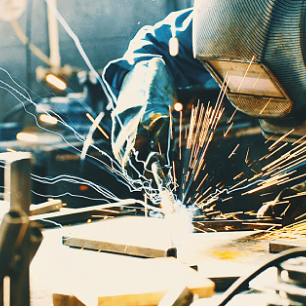Jump to:
Safe Cobot Welding
How can you ensure safe welding with your new collaborative robot (cobot)? In the rapidly evolving realm of industrial automation, cobots have swiftly emerged as a transformative solution, particularly in welding applications, offering unprecedented efficiency and adaptability. However, their integration introduces a unique set of safety considerations and protocols. While safety is always a priority in welding, it becomes even more critical when incorporating cobots. In this article, we delve into the essential safety features inherent in cobots and explore additional measures to establish a secure welding environment.
Best Practices to Abide By
Welding operations involving cobots present safety challenges that require careful consideration and proactive measures to protect workers and maintain a safe work environment. To be fully collaborative, all risks must be mitigated to a level acceptable for a human to interact directly with the automation. Several key preventative measures must be implemented to reduce risks associated with human-robot interaction.
Comprehensive Risk Assessment
This assessment helps in understanding the specific risks posed by welding arcs, sparks, fumes, and pinch points. Based on this evaluation, safety features such as collision detection sensors and emergency stop buttons should be integrated into the cobot system to prevent accidents and ensure rapid response to unforeseen circumstances.
Personnel Training
Training plays a critical role in promoting safety awareness and proper handling of cobots — Fig. 1. Operators and workers must receive thorough training on safe operating procedures, emergency protocols, and how to interact safely with cobots. Additionally, the provision of suitable personal protective equipment, such as welding helmets, gloves, and respiratory protection, is essential to safeguard workers against exposure to welding hazards.
Regular Maintenance & Inspection
Maintenance and inspections of cobots and welding equipment are crucial for identifying and addressing potential issues that could compromise safety or disrupt operations. These routine tasks involve thorough assessments of the cobot’s mechanical components, software systems, and welding equipment to ensure they function correctly and meet safety standards.
Potential Hazards
While cobot welding generally presents minimal risks, as with any robotic system, the possibility of encountering hazards exists. Understanding and addressing these risks is crucial, particularly in welding. The article will further discuss how cobots provide solutions to mitigate these risks.
Impact or Collision
Utilizing robot systems introduces a risk of impact, collision, or other struck-by or caught-between incidents. These stem from unforeseen movements, malfunctions, or alterations in programming that could lead to contact between the robot system and workers. Depending on the force involved, these interactions have the potential to cause injuries.
Projectiles
Another critical concern is the potential for workers to be struck by projectiles from the robot system. Mechanical failures, malfunctions in gripper mechanisms, or breakdowns in power tools can unexpectedly release parts, resulting in the expulsion of hazardous objects. These projectiles also pose risks of injuries determined by their velocity and impact force.
Hydraulic and Pneumatic Factors
The risks associated with robot systems are further compounded by hydraulic and pneumatic hazards. Ruptures in hydraulic and pneumatic lines can unleash high-pressure cutting streams and whipping hoses, presenting physical threats to nearby workers. Additionally, ruptures and leaks may expose workers to hazardous fluids/gases that are potentially toxic or flammable. Pressure losses stemming from such incidents can also trigger secondary hazards, such as scenarios involving workers being struck if a component of the robot system falls onto or swings into them.
UV Light and Additional Aspects
Exposure to UV light emitted during the welding process poses a threat to the skin and eyes, potentially leading to long-term damage if proper protective measures are not in place. Furthermore, the intense heat generated during welding can cause severe burns if workers come into contact with hot surfaces or molten metal. Moreover, the electrical components of cobot welding systems present a risk of electric shock if improperly maintained or if safety protocols are not followed diligently.
Cobot Safety Features
In cobots, prioritizing safety is crucial for fostering harmonious interaction with humans in shared workspaces. Incorporating advanced technologies, such as collision detection, hand guidance, stop buttons, and control systems, mitigates potential hazards. By prioritizing safety as a fundamental aspect of design and operation, cobots not only protect workers but also enhance productivity and facilitate seamless human-robot collaboration.
Collision Detection
Collision detection systems in cobots utilize sensors to detect when the robot encounters an obstruction, whether it’s an object or a person. The sensors can detect unexpected obstacles in the robot’s path, triggering a response to prevent collisions. When a potential collision is detected, the cobot can swiftly adjust its movements, slow down, or come to a complete stop, minimizing the risk of collision causing injuries in the workspace. This feature is essential for maintaining a safe working environment where humans and cobots can operate in close proximity without posing a threat to each other’s safety.
Hand Guidance
Hand-guiding capabilities in cobots enable direct physical interaction between humans and robots — Fig. 2. With this feature, a human operator can manually move the robot’s arm to demonstrate or teach it new tasks or positions. This intuitive programming method allows for quick and efficient task setup without complex programming knowledge. Moreover, hand guidance enhances safety by enabling precise control over the robot’s movements, reducing the likelihood of accidental collisions or errors. By facilitating seamless collaboration between humans and cobots, hand guidance promotes a more flexible and adaptive work environment where tasks can be easily modified or optimized.
Safety-Rated Stop Buttons
Safety-rated stop buttons are essential emergency features integrated into cobots to ensure the rapid halting of robot operations in critical situations. These stop buttons are strategically placed on or close to the tablet/controller/pendant and are easily accessible to human operators. This allows them to immediately halt robot movement in an emergency or unexpected hazard. This rapid response capability is crucial for preventing accidents and minimizing potential harm to humans or equipment within the workspace. By providing a reliable means of emergency shutdown, safety-rated stop buttons enhance the overall safety and usability of cobots, instilling confidence in operators and promoting a culture of safety in the workplace.
Software and Control Systems
Cobots’ software and control systems adhere to stringent safety standards like ISO 10218-1:2011, Robots and robotic devices — Safety requirements for industrial robots — Part 1: Robots; ISO 10218-2:2011, Robots and robotic devices — Safety requirements for industrial robots — Part 2: Robot systems and integration; and ISO/TS 15066:2016, Robots and robotic devices — Collaborative robots. These systems employ advanced algorithms and safety features to ensure safe operation, from motion planning to error detection. Ongoing advancements in safety-rated software enhance cobots’ safety and performance.
Concluding Thoughts
In the dynamic landscape of industrial automation, the integration of cobots into welding processes heralds remarkable efficiency and adaptability. However, this innovation necessitates a heightened emphasis on safety to safeguard workers and maintain secure work environments. A comprehensive risk assessment, personnel training, and regular maintenance can effectively mitigate potential hazards such as collisions, projectiles, and hydraulic/pneumatic risks. Cobots feature sophisticated safety measures, including collision detection, hand guidance, safety-rated stop buttons, and software and control systems, ensuring harmonious human interaction. By prioritizing safety at every stage, cobots not only protect workers but also enhance productivity, ushering in a new era of seamless human-robot collaboration in welding applications.
Works Consulted
1. Occupational Safety and Health Administration, OSHA Technical Manual (OTM) Section IV: Chapter 4. Retrieved September 20, 2024, from osha.gov/otm/section-4-safety-hazards/chapter-4.
2. National Ag Safety Database, Arc Welding Safety. Retrieved September 20, 2024, from nasdonline.org/1083/d000873/arc-welding-safety.html.
3. AFSCME, Health & Safety Fact Sheet. Retrieved September 20, 2024, from afscmestaff.org/wp-content/uploads/2020/03/Welding-Hazards-AFSCME-fact-sheet.pdf.
MITCH DUPON is the global director of cobots and DARBY CAUDLE (dcaudle@abicorusa.com) is the content marketing specialist, Abicor Binzel, Frederick, Md.


